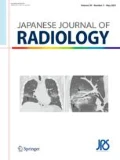Abstract
Purpose
On magnetic resonance imaging (MRI) sagittal sections, we sometimes encounter abnormal aspects of the superior profile of the midbrain and the cingulate sulcus in patients with dementia. In this preliminary study, we refer to these findings as the “upper midbrain profile sign” and the “cingulate sulcus sign.” We prospectively evaluated the usefulness of these signs for the diagnosis of idiopathic normal-pressure hydrocephalus (iNPH), Alzheimer's disease (AD) and progressive supranuclear palsy (PSP).
Materials and methods
We evaluated the upper midbrain profile sign and the cingulate sulcus sign on MRI sagittal images obtained from 21 people with headaches but no neurological deficit (controls), 10 iNPH patients, 11 AD patients, and 5 PSP patients. The upper midbrain profile sign indicated a concave shape to the superior profile of the midbrain on mid-sagittal images, and the cingulate sulcus sign indicated a narrow, tight aspect of the posterior part of the cingulate sulcus on paramedian-sagittal images.
Results
These signs were never seen in any images from the controls. The upper midbrain profile sign was seen in 7 of 10 patients with iNPH, 5 of 11 with AD, and 3 of 5 with PSP. The cingulate sulcus sign was seen in all 10 patients with iNPH but was never seen in any patient with AD or PSP.
Conclusion
The upper midbrain profile sign could support a diagnosis of PSP but cannot discriminate among iNPH, AD, and PSP. In contrast, the cingulate sulcus sign has a very high sensitivity for iNPH and should facilitate the distinction of iNPH from other dementias. In the clinical setting, it is momentous to evaluate these signs easily by one simple MRI sequence.
Similar content being viewed by others
References
Y Xu CRJ Jack PC O'Brien E Kokmen GE Smith RJ Ivnik et al. (2000) ArticleTitleUsefulness of MRI measures of entorhinal cortex versus hippocampus in AD Neurology 54 1760–7 Occurrence Handle10802781 Occurrence Handle1:STN:280:DC%2BD3c3msVCntQ%3D%3D
CRJ Jack RC Petersen Y Xu PC O'Brien GE Smith RJ Ivnik et al. (2000) ArticleTitleRates of hippocampal atrophy correlate with change in clinical status in aging and AD Neurology 55 484–9 Occurrence Handle10953178
AT Du N Schuff D Amend MP Laakso TT Hsu WJ Jagust et al. (2001) ArticleTitleMagnetic resonance imaging of the entorhinal cortex and hippocampus in mild cognitive impairment and Alzheimer's disease J Neurol Neurosurg Psychiatry 71 441–7 Occurrence Handle11561025 Occurrence Handle1:STN:280:DC%2BD3Mrhtlaisg%3D%3D Occurrence Handle10.1136/jnnp.71.4.441
GF Busatto GE Garrido OP Almeida CC Castro CH Camargo CG Cid et al. (2003) ArticleTitleA voxel-based morphometry study of temporal lobe gray matter reductions in Alzheimer's disease Neurobiol Aging 24 221–31 Occurrence Handle12498956 Occurrence Handle10.1016/S0197-4580(02)00084-2
K Ishii T Kawachi H Sasaki AK Kono T Fukuda Y Kojima et al. (2005) ArticleTitleVoxel-based morphometric comparison between early- and late-onset mild Alzheimer's disease and assessment of diagnostic performance of Z score images AJNR Am J Neuroradiol 26 333–40 Occurrence Handle15709131
M Adachi S Kawakatsu T Hosoya K Otani T Honma A Shibata et al. (2003) ArticleTitleMorphology of the inner structure of the hippocampal formation in Alzheimer disease AJNR Am J Neuroradiol 24 1575–81 Occurrence Handle13679273
A Righini A Antonini R De Notaris E Bianchini N Meucci G Sacilotto et al. (2004) ArticleTitleMR imaging of the superior profile of the midbrain: differential diagnosis between progressive supranuclear palsy and Parkinson disease AJNR Am J Neuroradiol 25 927–32 Occurrence Handle15205125
H Kitagaki E Mori K Ishii S Yamaji N Hirono T Imamura (1998) ArticleTitleCSF spaces in idiopathic normal pressure hydrocephalus; morphology and volumetry AJNR Am J Neuroradiol 19 1277–84 Occurrence Handle9726467 Occurrence Handle1:STN:280:DyaK1czptlSlug%3D%3D
C Gyldensted (1977) ArticleTitleMeasurements of the normal ventricular system and hemispheric sulci of 100 adults with computed tomography Neuroradiology 14 183–92 Occurrence Handle304535 Occurrence Handle1:STN:280:CSeD1M3mtlI%3D Occurrence Handle10.1007/BF00496982
Author information
Authors and Affiliations
Corresponding author
About this article
Cite this article
Adachi, M., Kawanami, T., Ohshima, F. et al. Upper midbrain profile sign and cingulate sulcus sign: MRI findings on sagittal images in idiopathic normal-pressure hydrocephalus, Alzheimer's disease, and progressive supranuclear palsy. Radiat Med 24, 568–572 (2006). https://doi.org/10.1007/s11604-006-0074-6
Received:
Accepted:
Issue Date:
DOI: https://doi.org/10.1007/s11604-006-0074-6




